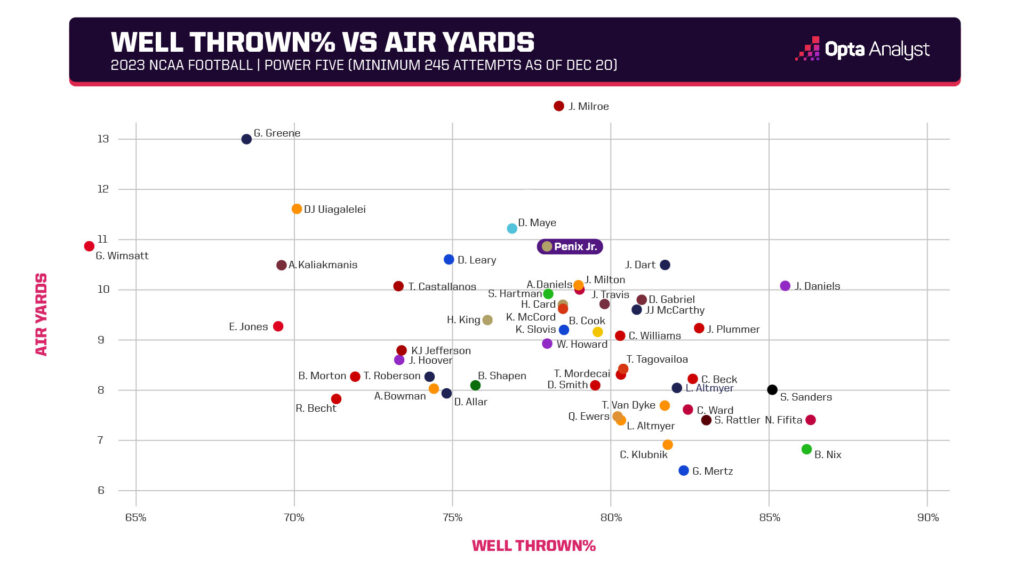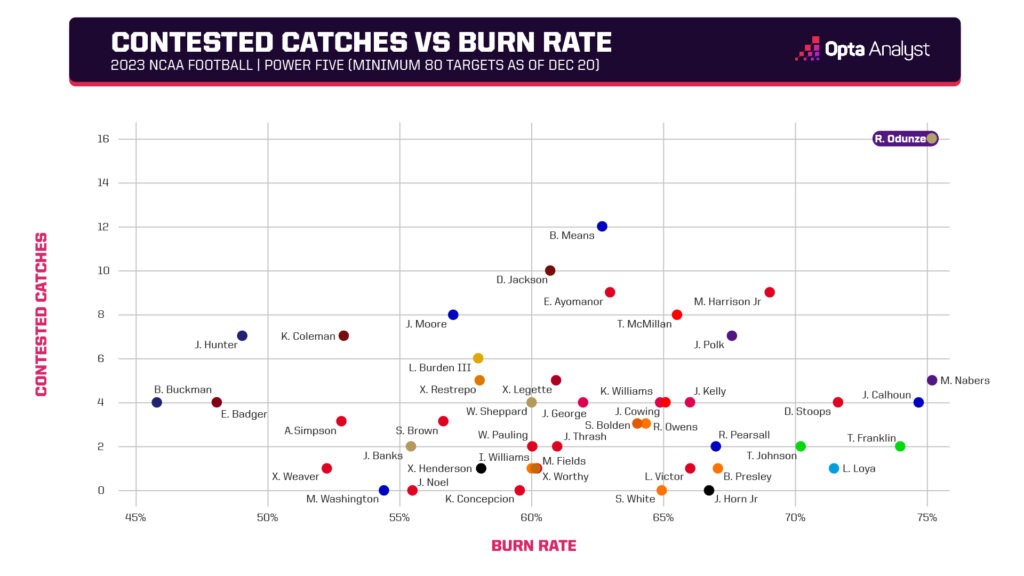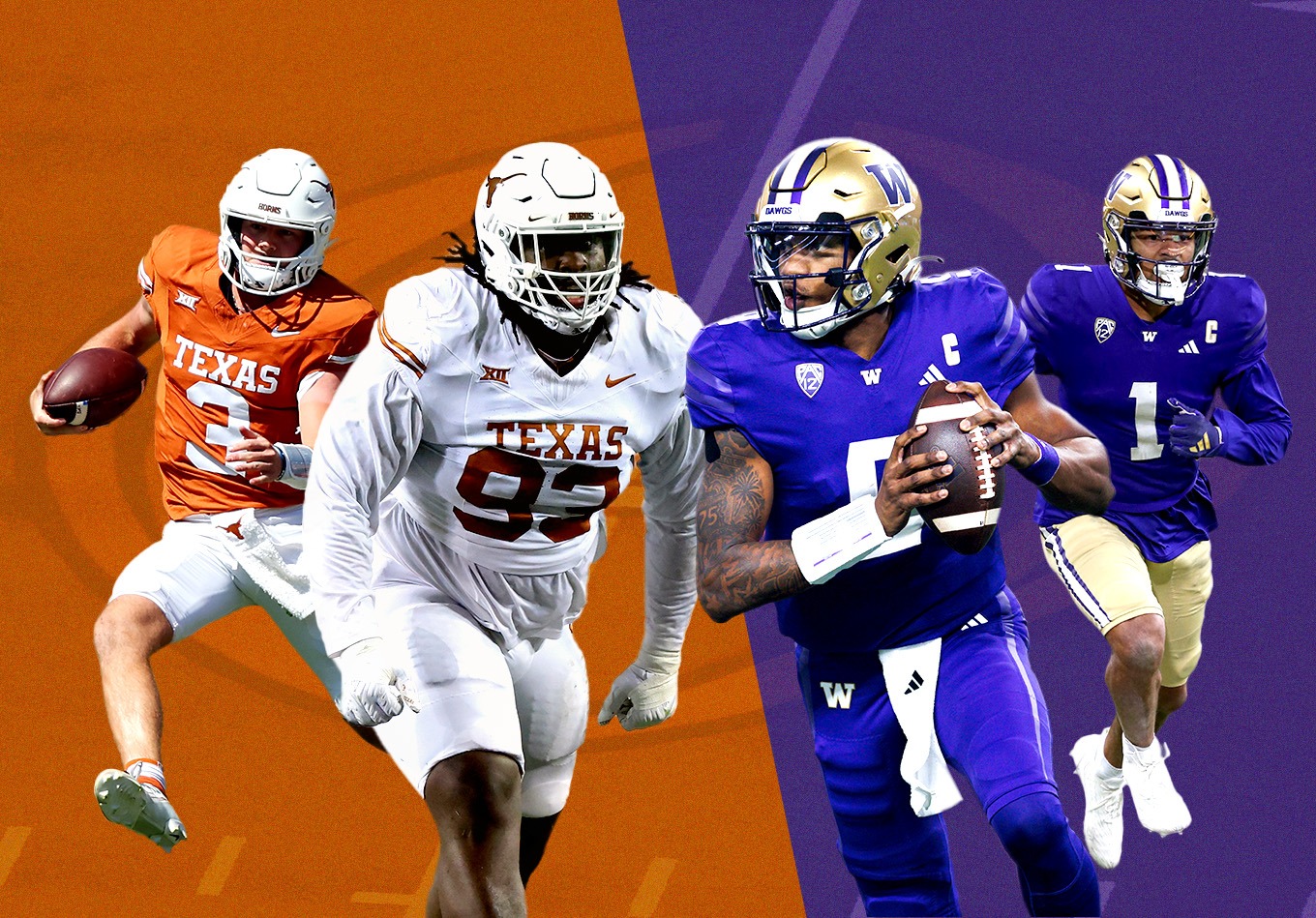At long last, the wait is almost over.
And despite the unquestionable controversy about how the College Football Playoff’s teams were picked, what’s done is done, as we have two projected thrillers coming up on New Year’s Day.
Both based on advanced stats and some miscellaneous fun facts, here’s what to look out for in the nightcap when the Texas Longhorns (No. 3) and Washington Huskies (No. 2) face off at the Caesars Superdome in New Orleans (on ESPN).
While the Rose Bowl between No. 1 Michigan and No. 4 Alabama will be a battle between programs that have been mainstays in the College Football Playoff in recent years, this game is anything but.
From the Longhorns’ perspective, while this phrase has been a meme in the college football world for the past decade, it’s finally time to admit it: Texas is back. This will be the first time that Texas plays in the BCS title game or CFP since Colt McCoy’s final season in 2009, when the Longhorns went undefeated in the regular season and fell to Alabama in the BCS National Championship following an injury to McCoy.
After dispatching Oklahoma State in the Big 12 Championship, Texas’ 12 wins are its most since finishing with 13 in 2009. Additionally, it’s only the program’s second 10-win season since having a nine-year streak from 2001-09, as the program went 10-4 in 2018 (when Sam Ehlinger memorably gave a “we’re back” proclamation that came a few years too early). This will be Texas’ third time playing in the BCS title game or CFP, with McCoy’s 2009 team also being joined by the Vince Young-led 2005 squad that took down USC in an iconic championship game.
But Washington has its own right to claim “back” status, having brought an entire conference back to relevance (even if only for a year). This is the first CFP appearance for any Pac-12 team since Washington in 2016, representing by far the longest drought for any Power Five conference over the CFP’s 10-year history. Washington became the conference’s first team to finish a regular season undefeated since Oregon in 2010 – back when the conference was still the Pac-10. If the Huskies win two more games, they will be the first Pac-10/Pac-12 team to win the national championship since USC in 2004.
Within the Washington program itself, history has been made as well. The team’s 13 wins have set a school record, which was previously 12 (in 2016 and 1991). The 1991 season was a particularly notable one in college football lore, as 12-0 Washington split the title with 12-0 Miami, representing the lone national championship in Washington’s history. This led to the creation of the “Bowl Coalition” the following year, which was college football’s first attempt at having an actual national championship game rather than strictly using polls, and was the ancestor to the Bowl Alliance, BCS, and College Football Playoff.
The Forgotten Rematch
Washington’s most recent game was a rematch the entire country was aware of, with the Huskies taking down Oregon by a three-point margin for the second time this season in the Pac-12 Championship game. But, more sneakily, the Sugar Bowl will also feature two teams familiar with one another.
Washington vs. Texas was the matchup in last year’s Alamo Bowl, and the Huskies took home a 27-20 win in San Antonio. And while both teams’ rosters have seen some overturn since then, many of the key figures from that showdown will return.
Both of this year’s starting quarterbacks took the field in that game, with Texas’ Quinn Ewers (31 of 47, 369 yards, 1 touchdown) outperforming Washington’s Michael Penix Jr. (32 of 54, 287 yards, 2 TD, 1 interception) by traditional metrics. But two core factors led to the final outcome, both of which could play a major role in New Orleans.
For one, Washington dominated up front. The Huskies ran for 158 yards and a touchdown on 28 carries and they did not concede a sack, or even a tackle for loss, in the entire game. In contrast, with Bijan Robinson having opted out, Texas was limited to a meager 51 rushing yards and a TD on 18 carries. Given that this year’s star Texas running back, Jonathan Brooks (1,139 rushing yards, 10 TD in 10 games), is out for the season with a torn ACL, the Longhorns will need to turn to younger backs CJ Baxter and Jaydon Blue to reverse the trend from last year’s game.
Secondly, while Penix’s yardage numbers weren’t gaudy, he did a pristine job of spreading the ball around. Penix is generally most known for the deep ball (more on that below), but in this game, he averaged an uncharacteristically low 9.0 passing yards per completion. What he lacked in explosiveness, though, he made up for with balance, as six different Huskies had at least three receptions and each of Washington’s current “Big Three” (Rome Odunze, Jalen McMillan, Ja’Lynn Polk) had at least 45 receiving yards.
From a more historical lens, this will be the second time that a CFP game features two teams who faced off in a non-CFP bowl game the prior year. Clemson defeated Oklahoma 40-6 in the 2014 Russell Athletic Bowl, before the Tigers also beat the Sooners 37-17 in the ensuing year’s CFP semifinal.
The Cardiac Kids
If you feel like every Washington game this year has gone the exact same way, you’re on to something.
Remarkably, each of Washington’s past nine games have been wins by 10 or fewer points. That’s the longest single-season streak of such games by any team in major college football history.
Even if we allow spanning of multiple seasons, it’s the longest streak since Princeton had 10 straight such games from 1878-79 … back when games didn’t really have shootouts since we were still more than 25 years away from the forward pass being legal.
Another fun fact? Before this year’s Washington squad, the longest single-season streak of such games was seven, which has been done on four occasions – most recently by none other than last season’s TCU team. While we all remember how the Horned Frogs’ season ended, we also can’t ignore that they did win a thrilling CFP semifinal game against Michigan before that.
Which Passing Game Has the Edge?
It’s no secret that both of these teams are defined by their passing units, with Penix being the Heisman runner-up and Ewers likely having a chance to be a finalist if he didn’t miss time with a shoulder injury. But which elite aerial attack is in the best position to succeed on Jan. 1?
Penix leads the nation with 4,218 passing yards, and those yards haven’t come easily. Among 130 FBS QBs with at least 150 attempts, Penix ranks 15th by averaging 10.9 air yards per attempt this season (Ewers has the 16th-lowest total at 7.53). Penix has the second-best well-thrown percentage of those 15 quarterbacks (78.0%) behind only Jalen Milroe of Alabama (78.3%).

When Penix does load up to throw deep, his top target has been Odunze, a finalist for the Biletnikoff Award (won by Ohio State’s Marvin Harrison Jr.). The senior has dominated in just about any metric out there, but one that particularly stands out is his ability to make contested catches.
Odunze has made a staggering 16 contested catches this season, four more than the next-closest FBS player (Pittsburgh’s Bub Means with 12). And when you combine those legendary ball skills with an ability to create separation, that’s a blend that leads to arguably the nation’s best wide receiver.
The below graph shows how Odunze’s contested catches and his “burns” (tracks when a receiver “wins” his matchup against a defender on a play that he is targeted) stack up to the rest of the nation.

Talk about an outlier. Yet, when discussing Washington’s receiving unit, McMillan’s return to form also can’t be slept on. McMillan had more receptions and touchdowns than Odunze in 2022, and he was off to another blistering start in 2023 with 311 receiving yards and three touchdowns in two-plus games before suffering a knee injury in Washington’s third game against Michigan State.
The underdog Huskies (Texas is a 4.5-point favorite) have largely gotten their undefeated record without McMillan’s assistance, but over the past couple of games, he’s added a boost to the lineup. McMillan has had at least five receptions in each of the past two games after entering that stretch with zero catches since the Michigan State game. Most recently, his game-high 131 receiving yards against Oregon were vital in the Huskies’ conference title win.
With McMillan appearing to be back at full strength, the Texas secondary will have its hands full, but our TRACR (Team Rating Adjusted for Conference and Roster) rankings suggest the Longhorns could be up to the challenge. Texas ranks 19th in defensive TRACR against the pass, compared to Washington’s 36th. An even larger discrepancy exists between each team’s run defense, as Texas ranks third (trailing only UCLA and Nebraska), while Washington ranks 74th.
For Texas to take advantage of these holes in Washington’s defense, Ewers will likely have to play with the same M.O. he has all season – take what the defense gives in the short game and don’t be afraid to try the deep shot when it’s there. Ewers’ air yards/attempt is shorter than the national average, but that’s also led to the sophomore having top-10 national ranks in completion percentage (73.2), open target percentage (84.7) and catchable throw percentage (81.1).
With one glance at Ewers’ highlights against Alabama, it’s evident that he’s willing to stretch the defense vertically. And when he does so in New Orleans, the benefactors will likely be the same as they were in Tuscaloosa: Xavier Worthy and Adonai Mitchell. Worthy has been a model of consistency this year, with at least four receptions in all but one of Texas’ games, and he’s 31 yards shy of his first career 1,000-yard receiving season.
Mitchell, in contrast, has been as much of a “big game” player as there is in the sport. The Georgia transfer has played in four career CFP games – all wins – and he’s caught a touchdown in all four of them.
If Mitchell’s playoff magic traveled with him from Athens to Austin, then we very well might have an instant classic on our hands.
Projected Winner: Washington
Win Probability: 57.7%
Check out our MLB offseason news, NBA in-season coverage, our NFL picks and our CFB TRACR rankings. Follow us on X and Instagram for more!
